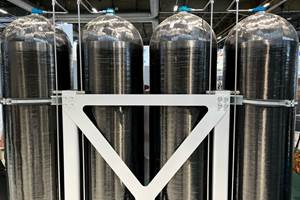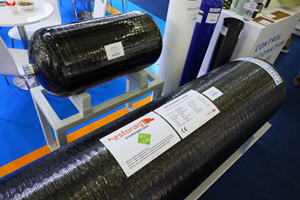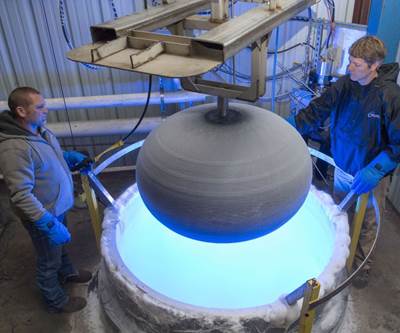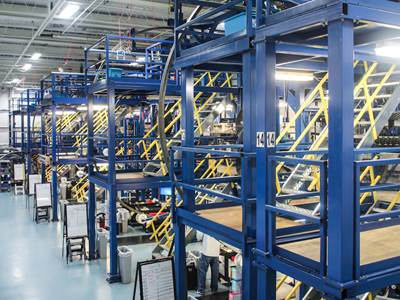Lockheed Martin Australia and Omni Tanker develop new composite tanks for cryogenic fuels
Partnership aims to commercialize Type IV and V tanks using patented OmniBIND technology for Lockheed Martin and NASA applications.
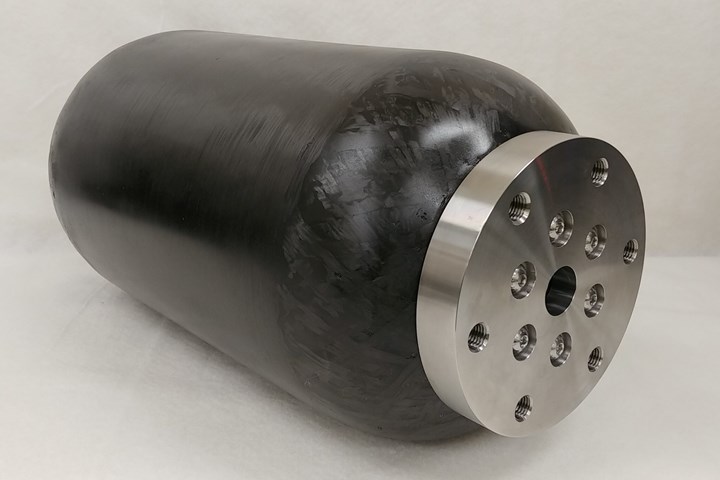
Linerless liquid hydrogen tank made using carbon fiber. Photo Credit: Advanced Manufacturing Growth Centre Ltd. (AMGC)
A collaborative partnership between Lockheed Martin Australia (Canberra), Australian manufacturer Omni Tanker (Smeaton Grange, NSW) and University of New South Wales (UNSW) seeks to develop and commercialize world-first composite tank technologies, thanks to a grant from the Federal Government’s Advanced Manufacturing Growth Centre (AMGC).
The co-funded project is part of AMGC’s Commercialization Fund launch and worth a total $1.4 million, will utilize two home-grown technologies to solve the challenges of using composites for the transportation and storage of liquid hydrogen with applications on ground, in the air, underwater and in space.
Combining nano-engineering technology developed by UNSW in partnership with Lockheed Martin and Omni Tanker, and Omni Tanker’s patented OmniBIND technology, the collaboration will result in the development of two new operational scale propellant tanks for storing cryogenic liquid fuels for commercial and civil satellite programs: a “Type IV” fluoropolymer-lined carbon fiber composite tank and a “Type V” linerless carbon fiber composite tank, both of which are suitable for high pressures, the extreme cryogenic temperatures required for liquid hydrogen as well as oxygen, hydrogen peroxide and hydrazine.
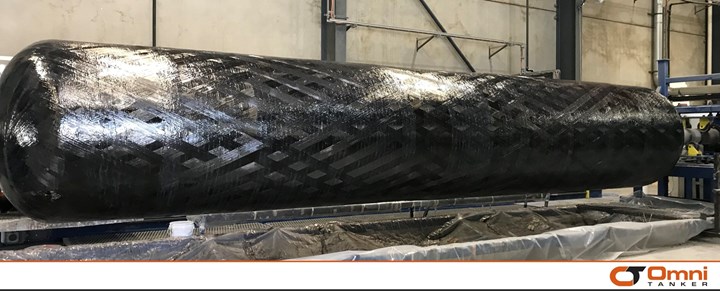
Large carbon fiber-reinforced composite pressure vessel. Photo Credit: Advanced Manufacturing Growth Centre Ltd. (AMGC)
Christopher Hess, head of industrial development for Lockheed Martin Australia acknowledged the support of AMGC and welcomed the opportunity for ongoing collaboration with UNSW and Omni Tanker.
“Lockheed Martin invests millions of dollars every year into R&D programs with our Australian industry and research partners to solve real challenges facing our Global Supply Chains,” he says. “We have had a long-standing research collaboration with UNSW and Omni Tanker, and we are grateful for the support of the AMGC as we now look to commercialize these cutting-edge, Australian-developed composite tank technologies for a number of Lockheed Martin and NASA applications.”
David Ball, regional director Australia and New Zealand for Lockheed Martin Space, confirmed that the development of composite tanks which are lightweight, cost-effective and resistant to microcracking and permeation, represents a unique and innovative technological solution with significant space applications.
“As the world increasingly looks to hydrogen for emission-free energy, containing and transporting it in a safe, cost-effective and economic manner remains extremely challenging,” says Ball. “The space industry is particularly interested in the development of linerless composite tanks for their weight efficiency and durability, which represent the cutting edge of composite pressure vessel manufacturing.
“These advances have the potential to support the growth of Australia’s sovereign space capabilities, strengthen exports to space-faring allies and partner nations and make an important technological contribution to future space missions particularly in on-orbit storage, launch and deep space exploration,” he continues.
“Creating a lightweight vessel for transporting liquid hydrogen at minus 253 degrees Celsius is no simple thing — whether you’re moving it along a highway or to outer space — but it’s Australian know-how that is making it possible,” says Dr. Jens Goennemann, managing director of AMGC. “That’s why AMGC is supporting Omni Tanker and its collaborative partners to engineer and manufacture a solution to this problem and offer it globally.”
The project builds on a recent invention by the research team at UNSW led by Professor Chun Wang, which enables carbon fiber composites to withstand liquid hydrogen temperatures without matrix cracks — a challenge that has, up until now, prevented mass-market adoption of these materials for such applications. “This new technology is the result of a collaboration and partnership between UNSW, Lockheed Martin and Omni Tanker over the past four years,” says Wang. “It is wonderful seeing our research achievement is now moving closer towards commercial success and generating social and economic impact in Australia and beyond.”
Omni Tanker, with its experience in the development and commercialization of strong, lightweight composite transport vessels, says it has the know-how and technology to translate the recent research innovations for a myriad of applications. “This next phase in our collaboration with Lockheed Martin and UNSW is a landmark development that sees Omni Tanker’s seamless thermoplastic lining technology enter the aerospace sector,” adds Omni Tanker CEO, Daniel Rodgers. “The OmniBIND technology has made inroads to revolutionizing the safe and efficient movement of challenging liquids within the chemical transport sector. Now, the growing need to decarbonize the energy industry, and the re-usable low-earth-orbit satellite market, have the potential to drive major utilization for these new technologies.”
Related Content
Toray announces growth, investment in carbon fiber composite materials
As part of its 2023-2025 management strategy, Toray projects 42% growth for pressure vessels, 30% growth in carbon fiber composite materials revenue and a doubling of capital investment.
Read MoreComposites end markets: Batteries and fuel cells (2024)
As the number of battery and fuel cell electric vehicles (EVs) grows, so do the opportunities for composites in battery enclosures and components for fuel cells.
Read MoreRecycling hydrogen tanks to produce automotive structural components
Voith Composites and partners develop recycling solutions for hydrogen storage tanks and manufacturing methods to produce automotive parts from the recycled materials.
Read MoreMikrosam, H2Storage collaborate on 300+-liter Type IV hydrogen tanks
Automated filament winding cell achieving wind speeds of 6 meters/second improves production performance, shortens curing cycle for serial production of 700-bar Type IV tanks.
Read MoreRead Next
Carbon fiber composite liner-less pressure tank handles cryogenic temps
Cimarron Composites has made a leap forward in all-composite cryogenic tank development.
Read MorePlant tour: A&P, Cincinnati, OH
A&P has made a name for itself as a braider, but the depth and breadth of its technical aptitude comes into sharp focus with a peek behind usually closed doors.
Read MoreModeling and characterization of crushable composite structures
How the predictive tool “CZone” is applied to simulate the axial crushing response of composites, providing valuable insights into their use for motorsport applications.
Read More

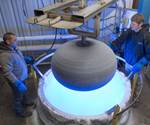
















.jpg;maxWidth=300;quality=90)


